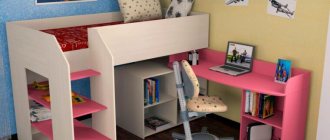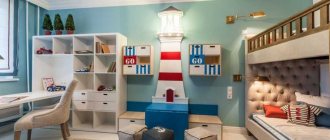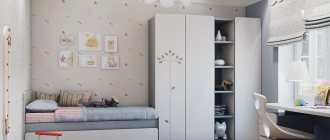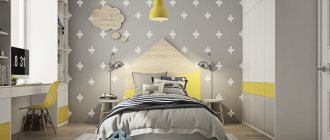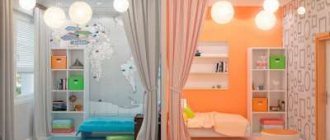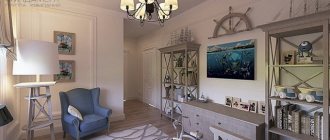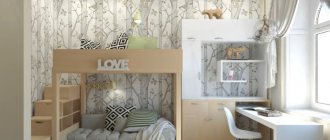In a small nursery, it is important to create a cozy and multifunctional space, despite the compact dimensions of the room. Even in the smallest room, the child will spend a lot of time: resting, playing, studying, and welcoming guests. Therefore, the design of this room should be taken as responsibly as possible. In this article you will learn how to create a full-fledged children's room with all the necessary areas in a small area.
What style to choose to decorate a small children's room
The design of a children's room depends on the gender and age of the child, his preferences. If a boy is interested in football, posters, graphics and thematic drawings are suitable for decorating the walls. For girls - multi-level ceilings with three-dimensional figures: butterflies, flowers. But the small space of a room often limits possibilities.
On a note!
A marine theme, a small room in a Scandinavian style, a loft, Provence or minimalism would be suitable, but it all depends on the child’s imagination.
Small room for a boy: what you can come up with
The ideal room in the dreams of the smallest conqueror may resemble the deck of a pirate ship or an observatory.
The interior of a little boy's room can be made a little fantastic, but most importantly - practical, so that the same fairy tale does not get boring as he grows up.
Let's start with the fact that for a small explorer's abode, the color scheme of Marina and Colonial styles is suitable. Successful examples of basic marine combinations: white and blue, sand and turquoise, light green with brown and blue accents.
This style will be complemented by striped prints and colonial furnishings, from “fairytale wanderings” - a chest or an unusual floor lamp.
Zoning rules for small children's rooms
Not all apartments have a layout that allows for a large room for a child. But parents want the best for their child; he needs a place for games and entertainment. The room for him is a place of study and relaxation. A comfortable, bright and clean room will encourage neatness and independence. The child will understand what order means.
There are many ways to choose a place to sleep and find a convenient location for a schoolchild’s desk or educational games. Children lead an active lifestyle, and a wall bars or horizontal bar can become a sports area. It is worth dividing the space into an area for relaxation and games, using furniture, partitions, and lighting. The main thing is that the color scheme of the entire room should be consistent in the same style.
Children often leave toys on the floor. Racks with plastic drawers for small items will help you keep things organized. At the same time, this will be an educational and gaming process for the child. As he or she grows up, he or she will know that there is a designated place for everything in the room. This will be the boundary of the playing area.
No. 3. Age of the child and necessary furniture
The main problem that parents will have to solve is the correct arrangement of furniture and deciding which items are essential and which can be discarded. It is better to sacrifice some kind of cabinet, but make more space for outdoor games and sports. If we are talking about a teenager’s room, then it is better if he himself takes part in its arrangement, since he is already able to decide what and where should be for his maximum convenience.
In addition to the fact that it is better to place furniture around the perimeter, there are several more universal rules:
- It is better to give preference to minimally decorated, laconic furniture;
- the fewer angles, the better;
- The friends of a small room are tall and narrow pieces of furniture, but you shouldn’t line up cabinets all the way to the ceiling, otherwise you can make a small space even smaller.
A children's room is one of those rooms in an apartment where it is impossible to renovate and forget about the need to refresh it for 10 years. As the child grows, it will be necessary to update the furniture and decoration, and each time the child’s needs will change. This means that the approach to arranging the interior of a children's room will also be transformed. In this context, it will be more convenient to consider the basics of furnishing a small children's room, depending on the age of the child.
Furniture for babies and preschoolers
New parents won’t have to rack their brains for a long time about arranging a nursery. All that is needed is a crib, a changing table in a sufficiently lit area, a small chest of drawers for baby things and a chair for mom. Later it will be possible to complement the interior with a soft rug and a box with the first toys.
As the child gets to his feet and begins to consciously get acquainted with the world around him, the first redevelopment of the room is done. You will need another bed; it is better to take a spare size. It’s a good idea to get a spacious chest of drawers or a closet for children’s things, as well as a small children’s table and chair, which will become a prototype of the future workplace.
The remaining area should be free for active games . It is appropriate for a preschooler to organize a sports corner . Today, ready-made complexes are sold that are easy to assemble and install. They can be any size, and if there is a shortage of space, you can choose a mini-corner with parameters 80*60 cm .
Preschool children love to draw. To prevent the wallpaper from being damaged, some parents worry in advance about sticking special wallpaper for drawing on one wall: it contains the contours of numerous figures that the kids will have to color. Another option is to dedicate a wall or part of it to display your best work.
The worst enemy of a small space is clutter , which, as you know, becomes synonymous with a children's room. To make the space feel more spacious, it is necessary to provide places for storing toys . These can be either ordinary closed shelves and cabinets, or interesting baskets or chests - it all depends on the style of the room.
Furniture for primary schoolchildren
From the moment a child starts school, it is important to teach him to clearly separate time for classes and play, so work and play areas should be well separated from each other. Let the work area be compact, but isolated from others, which can be done by placing it on a low podium, against a wall or near a window, so that the play area is behind your back. Ready-made complexes are perfect , in which there is a bed on the second tier, and a work desk with the necessary shelves and drawers on the first tier, but in this case, most likely, it will be necessary to devote more time to organizing the lighting. Near the desk there are shelves with textbooks and other school supplies necessary.
Starting from 6 years old, a child can sleep on the second tier of a bunk bed. The first tier is not necessarily the sleeping place for the youngest child. This could be a work or play corner, or a spacious closet. Moreover, shelves can also be built into the steps of the stairs leading to the sleeping place. This way the storage problem is solved, and at the same time there remains enough space for games and entertainment, which is especially important if there are several kids in the family, or the child often has guests of the same age.
To make a small children's room visually larger, you should use not very deep cabinets and shelves. Children's things are small, so for now you can use furniture of small depth.
It is better to give the vacated space to a sports complex with a rope, wall bars and rings, or to arrange toy houses, huts and other elements that will delight the child.
Small room for a teenager
The principles of organizing a room for a teenager are not much different from arranging the interior of an adult room. The play area disappears, and the work area and relaxation area grow along with storage areas. To accommodate everything you need, sometimes you have to place the bed on the second tier , use a folding sofa instead, which is not entirely good. An alternative is to place the bed on a podium and use its internal space for storage.
It is better to think through the design of the room with a teenager, who will indicate the preferred interior style. Children at this age often strive for bold decisions, and recently, increasingly, teenage rooms are decorated in the loft and minimalist style. Girls usually prefer Provence and Art Deco styles.
Color solutions
When choosing the color of the floor, walls, ceiling in the nursery, you should remember: in order to be comfortable, the room must evoke positive emotions. Too bright colors should be avoided; they can irritate and negatively affect the child’s psyche, provoking aggressiveness and overexcitement. Such a room will be far from comfortable and will not make you want to spend more time in it.
For preschoolers, it is better to use warm pastel colors or combinations thereof:
- peach;
- beige;
- light pink;
- lilac;
- blue;
- light green.
Bright inclusions are acceptable to help bring some life. It could be some kind of non-dark toy, picture or part of the built-in furniture. But you shouldn't abuse them.
On a note!
White and beige are good for decorating a teenager's room. The student needs a calm environment to prepare for classes and relax after classes.
Many people try to decorate a room in a laconic but cozy Scandinavian style. Comfort and homeliness are combined here. Cool tones of the walls are combined with warm shades of furniture, mainly made of wood. Non-bulky furniture conveys the atmosphere of housing in northern countries, where warmth is valued.
Monotony does not lift your spirits. Bright curtains, the color of furniture and blankets can serve as a contrast.
From 13 years and older
Teenager's room
And now the time has come when your “baby” prefers to be behind a closed door. He has a personal life, he becomes independent.
A teenager's room is a separate and often very personal world. Bright drawings are gone, cartoon characters are replaced by posters of musical groups and film actors.
But the main thing is that teenagers themselves take an active part in creating the interior of their room. They select their concepts, we discuss them with the parents and offer design options taking into account their wishes.
It is difficult to imagine the life of modern teenagers without a computer. Books and notebooks gradually fade into the background, abstracts are printed “in Word” and sent to teachers by email
